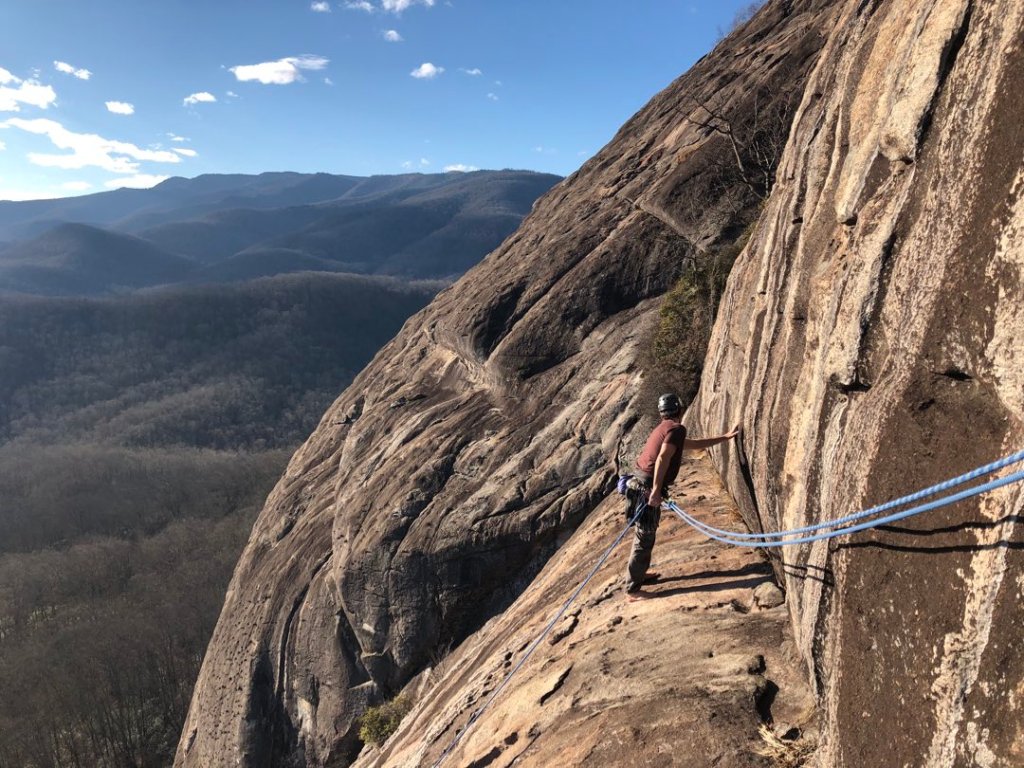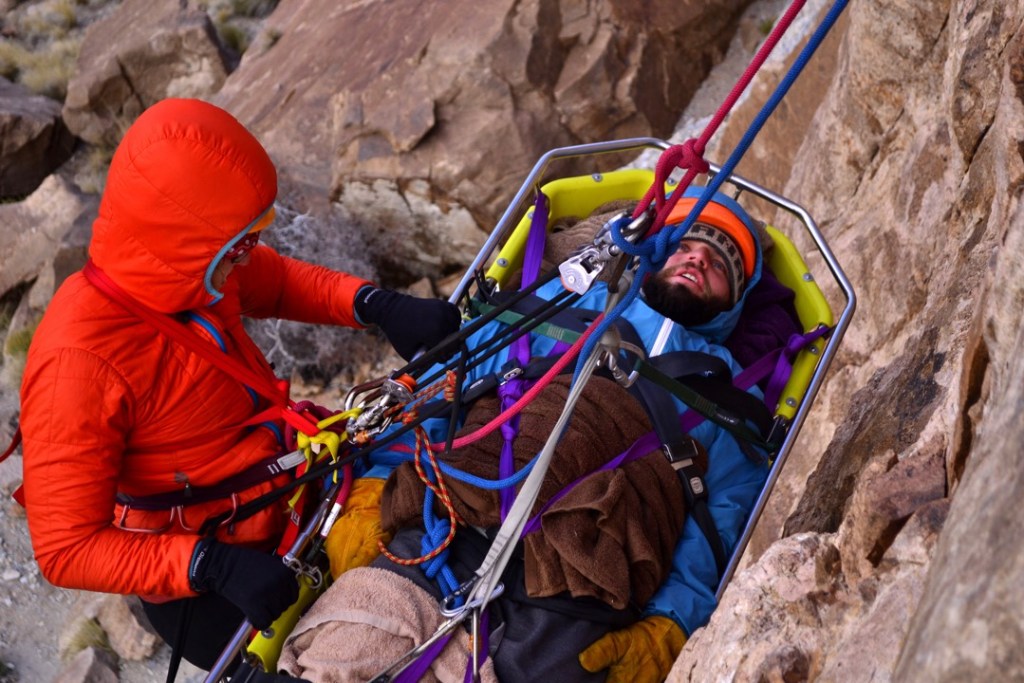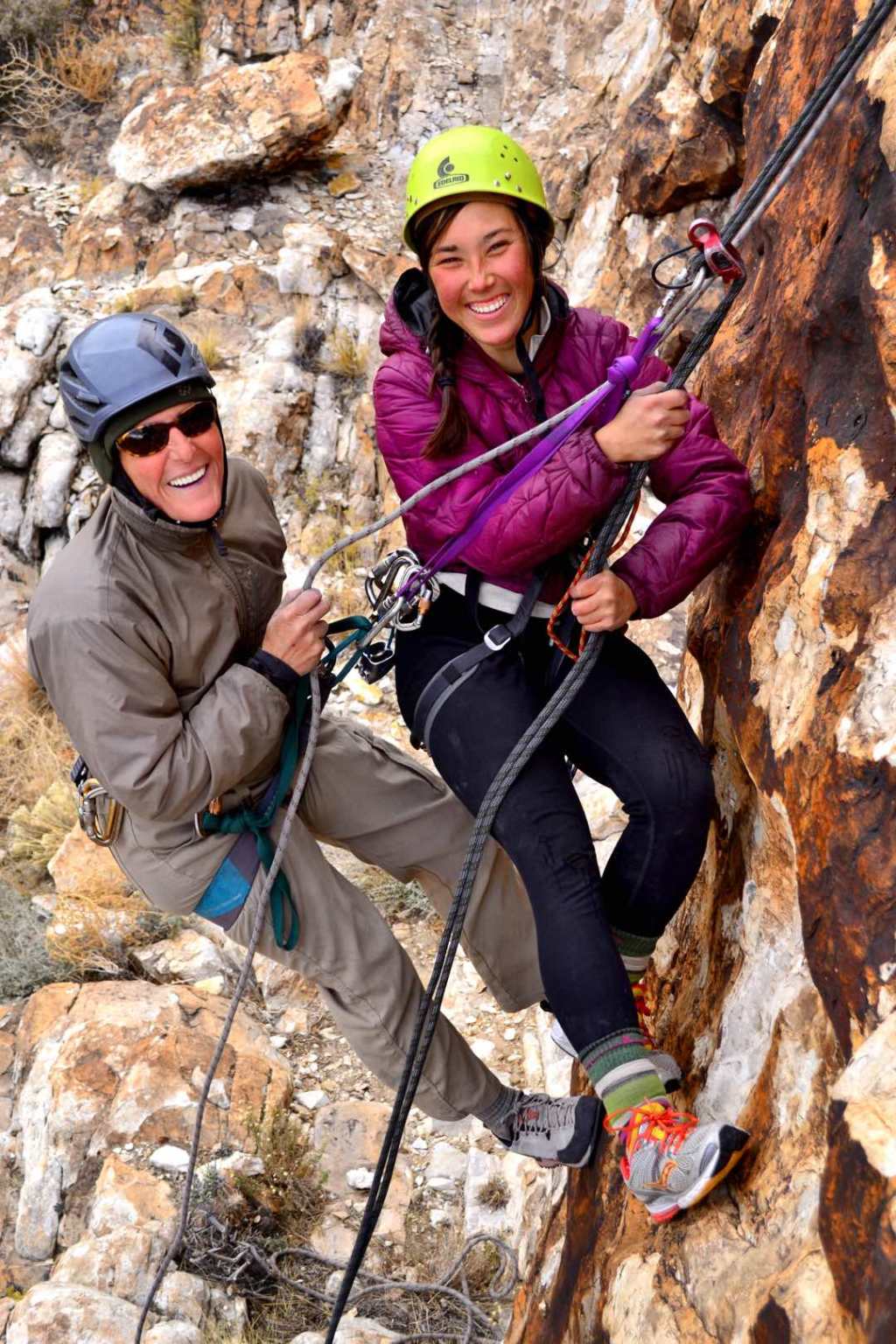I watched from the anchors up top as he free-fell off the end of his rope 150 feet to the ground. The wind whipped a tendril of hair across my eyes and I blinked, expecting him to be there when I opened them. A few seconds before, the azure Appalachian hills had filled me with awe. Now as I scanned the horizon for my fiancé, the scene darkened, morphing into a sickening, cavernous emptiness. He wasn’t there.
Feb. 2 had been a pleasantly warm winter day. The South Side of North Carolina’s Looking Glass Rock teemed with climbing parties and spectators. My fiancé, Jed Niffenegger, and I had climbed the two-pitch classic Dinkus Dog, rated 5.10b, and were on our way down.
At the bolted anchors, we set a rappel down to a tree between the route’s two pitches. Jed rappelled first and reached the end of the rope just shy of the tree. I observed him sussing out the situation, trying to rig a system of extended slings. A heartbeat later, he disappeared.
Although impossible to believe from my viewpoint, Jed survived—never losing consciousness. Trees, slabby ledges and thick undergrowth helped slow an otherwise likely fatal fall. I immediately called emergency services from my stance at the anchors. Between my cries for help and the wealth of neighboring parties, climbers were quickly on site to assess the situation. I didn’t want to risk rapping down toward the tree because I didn’t know what had happened with the system. So I stayed put, paralyzed by fear and helplessness until our friend Mark shouted up to me from below. He’d hiked in about an hour earlier to watch us climb.
“He’s OK!” Mark yelled, but the words processed like a foreign language through my auditory cortex. I didn’t believe him. Then my phone rang—my fiancé’s name lit up on the screen.
“I’m OK, really. I’ve been learning landing skills from our kitten,” Jed’s voice rang through the speaker. His words spurred a sort of frenzy in my mind and I don’t remember the next half hour, but I know a climber below had me lower my rope and tie his to it so that I could pull them back up and rappel a single line to the ground.

The author’s fiancé susses out the rappel off the top of their route before the accident. Photo credit: Amanda Ellis.
Barefoot and shaking, I down-climbed a small slab and plunged into the scene of the fall. My feet had been killing me while I’d waited to rappel, so I had taken my climbing shoes off and stashed them on my harness. After the accident, I was in such a panic it didn’t occur me to put them back, so I just rappelled barefoot to the ground and rushed onto the scene. A handful of people surrounded Jed, his body wrapped with jackets on the soft ground adjacent to thick brush. When I reached him, he smiled, and I think I finally breathed again.
In an accident, wilderness medicine protocol defers to the highest trained medical authority on the scene—in this case, a seasoned emergency room (ER) nurse, a climber who’d been watching her family nearby the scene of the accident. Although many of the climbers present boasted some level of wilderness medicine training, she took the lead. The fortune was simply surreal to me.
The ER nurse performed a focused spine assessment and determined it would be safe to move Jed if needed. Then we waited for help to arrive. After about an hour, the sun began to set and the temperature dropped. Concern rose as Jed continued to shiver despite the number of puffy jackets we wrapped around him. After a final physical evaluation, the nurse considered hypothermia an imminent threat and the group discussed carrying Jed toward the trailhead.
“Should we wait for the first responders?” I asked.
One of the climbers on the scene met my eyes, and said, “We are the first responders.”
He was concerned by the rugged terrain, including the boulder field leading from the approach trail to our location; there’s a difference between the speed of an adept climbing party and a volunteer rescue squad weighed down with supplies.
We banned together, two people forming a human litter for Jed by crossing and locking arms, switching out when someone began to tire. The rest of us divided up the packs and gear, shouldering extra loads as needed. While the going was slow, we carried Jed through the boulder field and down the approach trail three-quarters of the way back to the trailhead, where the rescue squad took over, taking him by ambulance and then helicopter to the nearest trauma center in Asheville. After three days in the trauma ward, the doctors deemed Jed well enough to return home and heal. He miraculously walked away from the accident with three broken ribs, corresponding fractured spinous processes, grisly road rash down his entire right side and a torn Achilles tendon that he had repaired back in Raleigh.
Although available data on climbing accidents is limited, we know this type of incident happens more often than we climbers would like to think. The American Alpine Club publication Accidents in North American Climbing reported 7,818 climbing accidents from 1951 to 2017, involving 14,108 people. And one study published in 2009 by the American Journal of Preventive Medicine found that more than 40,000 people were treated in emergency departments for rock-climbing-related injuries between 1990 and 2007, with over three-quarters of these injuries resulting from a fall.
My takeaway from this accident is how much value wilderness medicine training offers to rock climbers. We frequently spend time in areas off the beaten path and far from medical help, and the fact that accidents can happen high off the ground on a climbing route emphasizes the need for education, including climbing-specific rescue skills. Like the climber said to me that day, we are the first responders. It takes time, effort and money to be educated, but here are some basic resources to get started.

A student on a NOLS wilderness medicine and rescue semester class practices with a course mate. Photo credit: Tim Doyle/NOLS.
An Overview of Wilderness Medicine Training Courses
Wilderness First Aid (WFA): This two-day course is an introduction to wilderness medicine and involves learning the Patient Assessment System, how to provide effective first aid treatments for injuries and illnesses common in the outdoors, and how to make appropriate evacuation decisions.
Wilderness Advanced First Aid (WAFA): Offering more detailed first-aid training and patient stabilization methods than the WFA course, this 40-hour course is a step up from basic Wilderness First Aid and can be used toward a Wilderness First Responder certification.
Wilderness First Responder (WFR): Successful completion of this nine- to 10-day course rewards participants with WFR and advanced CPR certifications. The Wilderness First Responder certification is the industry standard for professional guides and search-and-rescue team members around the world.
Wilderness Emergency Medical Technician (EMT): This advanced monthlong program teaches both wilderness and urban medical care practices and awards successful participants with both EMT and Wilderness EMT certifications.
For more information, check out the International Wilderness Leadership School, Outward Bound or the National Outdoor Leadership School, which are leaders in wilderness education with medical certification offerings. You can find a list of class offerings, course costs, dates and locations on their respective websites. REI also partners with NOLS for wilderness medicine classes and events.

A NOLS instructor helps a student practice companion rescue. Photo Credit: Tim Doyle/NOLS.
Additional Educational Resources
Although learning how to administer first aid in the backcountry is invaluable, a few climbing-specific skills can also come in handy when things go sideways on a climbing route. Techniques like belay escape, hauling systems and and fixing ropes can be a huge help in an emergency situation. Here are a few resources to help you learn these skills.
REI Co-op: The REI Co-op offers a four-hour Rock Climbing Rescue Class that teaches belay escape techniques, how to ascend to aid an injured climber, and how to assist a climber from below.
International Wilderness Leadership School (IWLS): For more advanced rescue techniques, consider the IWLS certified two-day Low Angle Rescue and three-day High Angle Rescue courses designed to teach skills in harsh mountain environments.
Professional Guide Services: Rock climbing self-rescue course opportunities abound among professional climbing guide services and are not limited to the options outlined above.
